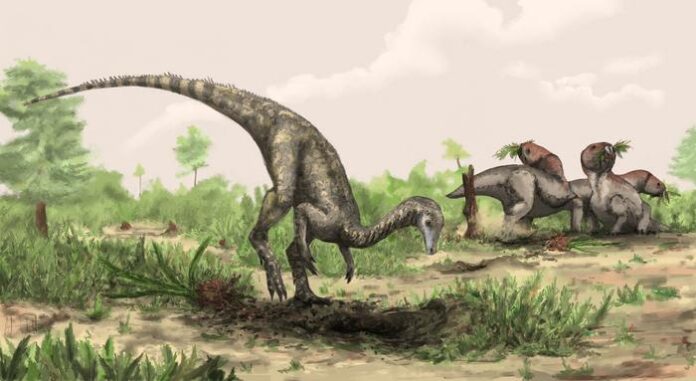Just because we haven’t found dinosaur bones near the equator doesn’t mean they don’t exist — just that we haven’t looked in the right places.
A study modeling the extinct beasts’ evolution, published in Current Biology, points to the earliest dinosaurs establishing themselves near the Earth’s center, then spreading out to other parts of the globe. So far, the oldest known dinosaur fossils — dating back about 230 million years — hail from farther south, including Brazil, Argentina, and Zimbabwe.
Rethinking Dinosaur Origins
But, because fossils from each area differ so much from each other, that suggests the creatures were already evolving. Following that line of logic meant that earlier versions of the creatures must have lived elsewhere. Experts hadn’t yet established where that “where” was and the ambiguity inspired the research team.
“Dinosaurs are well studied but we still don’t really know where they came from,” Joel Heath, a University College London graduate student and an author of the study, said in a news release. “The fossil record has such large gaps that it can’t be taken at face value.”
To point out possible dinosaur origin locations, the team built a computer model based on known fossil sites, evolutionary trees of dinosaurs and their reptile relatives, and geography. Perhaps most importantly, it treated areas that have not yet yielded dinosaur bones as areas where no fossils have been found — not where no fossils exist.
After putting all that information together, the team came up with a likely location — an equatorial supercontinent known as Gondwana. This area, which encompasses today’s Amazon, Congo basin, and Sahara Desert, was likely a hot, dry environment.
“So far, no dinosaur fossils have been found in the regions of Africa and South America that once formed this part of Gondwana,” said Heath. “However, this might be because researchers haven’t stumbled across the right rocks yet, due to a mix of inaccessibility and a relative lack of research efforts in these areas.”
Read More: A Complete Dinosaur Timeline to Extinction: How Long Did They Roam Earth?
Pinpointing Dinosaur Ground Zero
From that location, the creatures moved as they evolved, some south, into the areas where the oldest known fossils have been found. Others travelled north into Laurasia, the supercontinent that eventually split into Europe, Asia, and North America.
The fossil record supports the equatorial area as a sort of “Dino Ground Zero,” because it is literally a midpoint. Evidence of the earliest dinosaurs have been found in southern Gondwana, while other fossils of close relatives have been identified Laurasia.
The researchers suspect that if and when any dinosaur fossils are found there, they will be much smaller than fearsome beasts like Tyrannosaurus rex — more dog-sized than Godzilla-sized. Those bones will also likely be outnumbered by other small reptiles.
But first, paleontologists will need to start digging closer to the equator.
Article Sources
Our writers at Discovermagazine.com use peer-reviewed studies and high-quality sources for our articles, and our editors review for scientific accuracy and editorial standards. Review the sources used below for this article:
Before joining Discover Magazine, Paul Smaglik spent over 20 years as a science journalist, specializing in U.S. life science policy and global scientific career issues. He began his career in newspapers, but switched to scientific magazines. His work has appeared in publications including Science News, Science, Nature, and Scientific American.
Source : Discovermagazine






